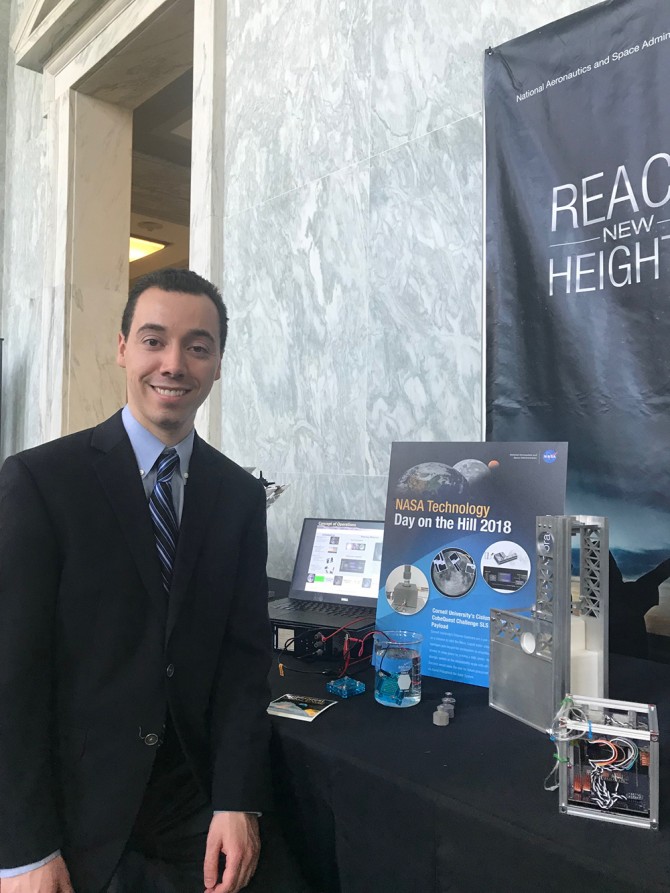Water-powered spacecraft displayed at NASA Tech Day
By Rachel Rhodes
Cornell’s CubeSat, a water propelled spacecraft weighing less than 25 pounds, was on display for lawmakers and staffers on May 9 at NASA’s Technology Day on Capitol Hill. The event highlighted new technologies in the aerospace industry, including those that may enable future exploratory missions to Mars or deep space asteroids.
The team from Cornell, Cislunar Explorers, was invited to present after winning NASA’s Cube Quest Challenge in 2017, which earned the group a spot for its spacecraft on the unmanned Orion mission scheduled to launch into deep space in 2020. Kyle Doyle, a doctoral student in mechanical and aerospace engineering, attended NASA’s Technology Day and presented a model of the Cornell CubeSat and a live demonstration of the electrolyzers used by CubeSat to break water into burnable hydrogen and oxygen – a key feature of Cislunar Explorers’ design.
“Water is easier to handle than other types of propellent, takes up less space and is more sustainable. What is exciting is that we didn’t know until recently how abundant water is throughout the solar system. Our mission with CubeSat is a technology demonstration that shows the potential for propelling spacecraft using water – paving the way for future space exploration anywhere water can be found,” said Doyle.
Mason Peck, faculty adviser to the Cislunar Explorers and a professor of mechanical and aerospace engineering, said it is critical for innovators to show elected representatives the successes of investment in space technology.
“Research in basic and applied science and technology sets the U.S. apart,” said Peck, a former NASA administrator. “Our economic strength, quality of life and global leadership hinge on our ability to lead the world in novel discoveries and technological innovation. We must continue this critically important work, and communicating the value of it to Congress may help stave off threats to technology and science investments that help bring the future to the present.”
Engagement opportunities like NASA’s Technology Day on the Hill provide a forum for scientists to interact face to face with lawmakers who manage federal funding of space technology research.
“The up-close-and-personal approach to this event helps personalize what might otherwise be inaccessible to people who don’t read technical journals,” Peck said. “Despite how exciting I think our research into a rocket engine that runs on water and sunlight is, a journal article isn’t enough. Telling this story in person can have greater impact than trying to do so through the usual academic channels. When we take our ideas to D.C., we’re trying to ensure they have the best chance to make an impact.”
When Cornell’s spacecraft launches with the Orion in 2020, it will be the first time a water-powered CubeSat is launched to attempt an orbit of the moon. Doyle said he hopes his work on CubeSat illustrates the need for additional programs like the Cube Quest Challenge: “We want to show how big the return on investement is for innovation competition programs, which make up just a small portion of NASA’s total budget.”
Peck added: “These competitions, or challenges, are a new way to generate unexpected solutions: They pose difficult problems that demand new paradigms and new thinking. It provides a way for NASA to break down barriers to entry and to bring the best ideas into NASA from wherever they can be found.”
Rachel Rhodes is a public affairs and media relations specialist in Cornell’s Washington, D.C., office.
Media Contact
Get Cornell news delivered right to your inbox.
Subscribe

